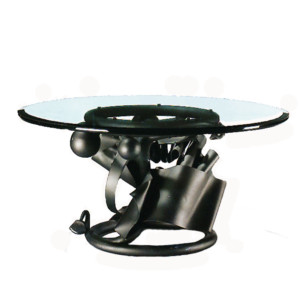(b.1944)
Albert Paley is among the most innovative and important contemporary designers. His work, usually in wrought iron, is highly original and distinctive, often using the vocabulary of the undulating, flowing lines of Art Nouveau, but in a distinctly modern way.
Albert Paley was born in Philadelphia in 1944. He attended Tyler School of Art at Temple University, receiveing his undergraduate degree, and earned a MFA in jewelry and metal-smithing as well, where he mastered the techniques that would enable him to develop new approaches to his materials.
During his studies, Paley also traveled to Europe to study the techniques of European metalwork. He visited numerous jewelers and metal-smiths, including the Pomodoro brothers, known for their beautiful and under-stated jewelry, and also Max Frolich. Through this exposure, he was able to gain valuable insights and perspectives regarding trends in metal work. He also established a number of important contacts.
For his graduate thesis, he explored brooch forms. He extensively researched Greek and Etruscan jewelry, especially the fibula, and this served him well in his later work in jewelry. He viewed his pieces as being balances of esthetics and function.
Paley began working seriously in wrought iron around 1970. He chose iron because it allowed him to work on a larger scale, and he enjoyed the immediacy of working with and transforming the material. He often worked intuitively. Rather than starting out with drawings and a precise plan for the finished work, he would allow each piece to develop as he worked, which imbued his pieces with a spontaneity and dynamic flow. The greater part of his work at this time was architectural ornamentation.
Paley is the first metal sculptor to receive the coveted Lifetime Achievement Award from the American Institute of Architects, the AIA’s highest award to a non-architect. He has been active as an artist for over 30 years. At his studio in Rochester, New York, he and his staff work in a variety of metalworking disciplines. His furniture pieces are distinctive for the way in which he uses metal – usually wrought iron. It is pulled, twisted, coiled, bent and cut so that each piece seems to take on a life of its own. His pieces are both organic and industrial, and reiterate certain aspects of Hector Guimard in their effortless flow of material. In fact, Paley has a personal collection of Art Nouveau in his home.
Commissioned by both public institutions and private corporations, Paley has completed more than 50 site-specific works. He established a studio in New York to produce his pieces, especially those that are very large in scale. Some notable examples are the Portal Gates for the Renwick Gallery of the Smithsonian Institution in Washington DC, the Portal Gates for the New York State Senate Chambers in Albany, a plaza sculpture for AT&T in Atlanta, GA, a sculpture and plaza designed for Adobe Systems in San Jose, CA, major entrance rotunda gates for the State Courthouse in San Francisco, the main entrance gates for the Naples Museum of Art, Naples, FL, as well as a 65-foot sculpture for the entry court of Bausch and Lomb’s headquarters in Rochester, NY.
Recently completed works include a pair of entrance sculptures for the Columbia Public Library, Columbia, Missouri, exterior archways for the town of Perry, Iowa, Sentinel, a monumental plaza sculpture for Rochester Institute of Technology, which is his largest work to date, and Animals Always, a ceremonial archway in Forest Park for the Saint Louis Zoo.
Furniture and other pieces by Albert Paley can be found in the permanent collections of many major museums, including the Metropolitan Museum of Art in New York, the Museum of Fine Arts in Boston, the Museum of Fine Arts in Houston, the Victoria and Albert Museum in London, the Art Gallery of Western Australia, Perth, Australia, the Fitzwilliam Museum, Cambridge University, England, and The British Museum in London.
Albert Paley’s work has been widely published, and he is also a noted international lecturer. In addition to his degrees from the Tyler School of Art in Pennsylvania, he has received honorary doctorates form the University of Rochester, in 1989, the State University at Brockport in 1996, and St. Lawrence University in 1997. He also holds an endowed chair at the Rochester Institute of Technology. He is truly a National Treasure.
Despite the acclaim he had garnered for his public projects and furniture designs, he never forgot his interest in jewelry, and continues to produce interesting pieces today.
Showing all 2 results



